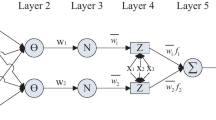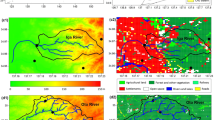Abstract
Antecedent physical factors are used in calculations, which endowed set pair analysis with predictive abilities. Set pair analysis can make predictions based on calculations using antecedent physical factors. In this study, the fitted value \( {\widehat{Y}}_1 \) based on set pair analysis agreed with the actual value of the average annual discharge grade at Yamadu Station, which showed that the prediction was valid. It’s predicted that the average annual discharge at Yamadu Station in 1975 was a dry year, i.e. y < 385 m3/s, while the actual average annual discharge at Yamadu Station in 1975 was 301 m3/s, which confirmed the prediction that it was a dry year. Three physical factors were not processed using set pair analysis so they could be compared with the calculated results. These factors were used directly to establish a regression equation for the average annual discharge grade and obtained a fitted value of \( {\widehat{Y}}_3 \) for the average annual discharge grade at Yamadu Station during 1953–1974. It’s known that the prediction of the average annual discharge grade for 1966 using a regression equation derived from the data differed from the actual situation, thereby indicating that set pair analysis can be used to improve the accuracy of predictions.
Similar content being viewed by others
References
Fan ZX (1999) Mid- and long-term hydrological forecasting. Hohai University Press, Nanjing, China
Feng LH, Hong W (2007) Forecast of meteorological disaster based on analysis of dominant hidden cycle. J Catastrophology 22(2):15–17
Gupta AS, Jain S, Kim JS (2011) Past climate, future perspective: an exploratory analysis using climate proxies and drought risk assessment to inform water resources management and policy in Maine, USA. J Environ Manag 92(3):941–947
Mays LW (2013) Groundwater resources sustainability: past, present, and future. Water Resour Manag 27:4409–4424
Pavlis M, Cummins E, McDonnell K (2010) Groundwater vulnerability assessment of plant protection products: a review. Hum Ecol Risk Assess 16(3):621–650
Wang ZL, Ma HL, Lai CG, Song HJ (2012) Set pair analysis model based on GIS to evaluation for flood damage risk. Procedia Eng 28:196–201
Welderufael WA, Woyessa YE, Edossa DC (2013) Impact of rainwater harvesting on water resources of the modder river basin, central region of South Africa. Agric Water Manag 116:218–227
Xu F, Zheng XP, Zhang J, Fu ZT, Zhang XS (2010) A hybrid reasoning mechanism integrated evidence theory and set pair analysis in Swine-Vet. Expert Syst Appl 37:7086–7093
Zhao KQ (1994) Set pair analysis and its preliminary application. Discov Nat 13(1):67–72
Zhao KQ (2007) The application of SPA-based identica-ldiscrepancy-contrary system theory in artificial intelligence research. Trans Intell Syst 2(5):20–35
Zhao KQ, Xuan AL (1996) Set pair theory – a new theory method of non-define and its applications. Syst Eng 14(1):18–23
Acknowledgments
This work was supported by National Natural Science Foundation of China (No. 41171430).
Author information
Authors and Affiliations
Corresponding author
Rights and permissions
About this article
Cite this article
Feng, L.H., Sang, G.S. & Hong, W.H. Statistical Prediction of Changes in Water Resources Trends Based on Set Pair Analysis. Water Resour Manage 28, 1703–1711 (2014). https://doi.org/10.1007/s11269-014-0581-7
Received:
Accepted:
Published:
Issue Date:
DOI: https://doi.org/10.1007/s11269-014-0581-7




